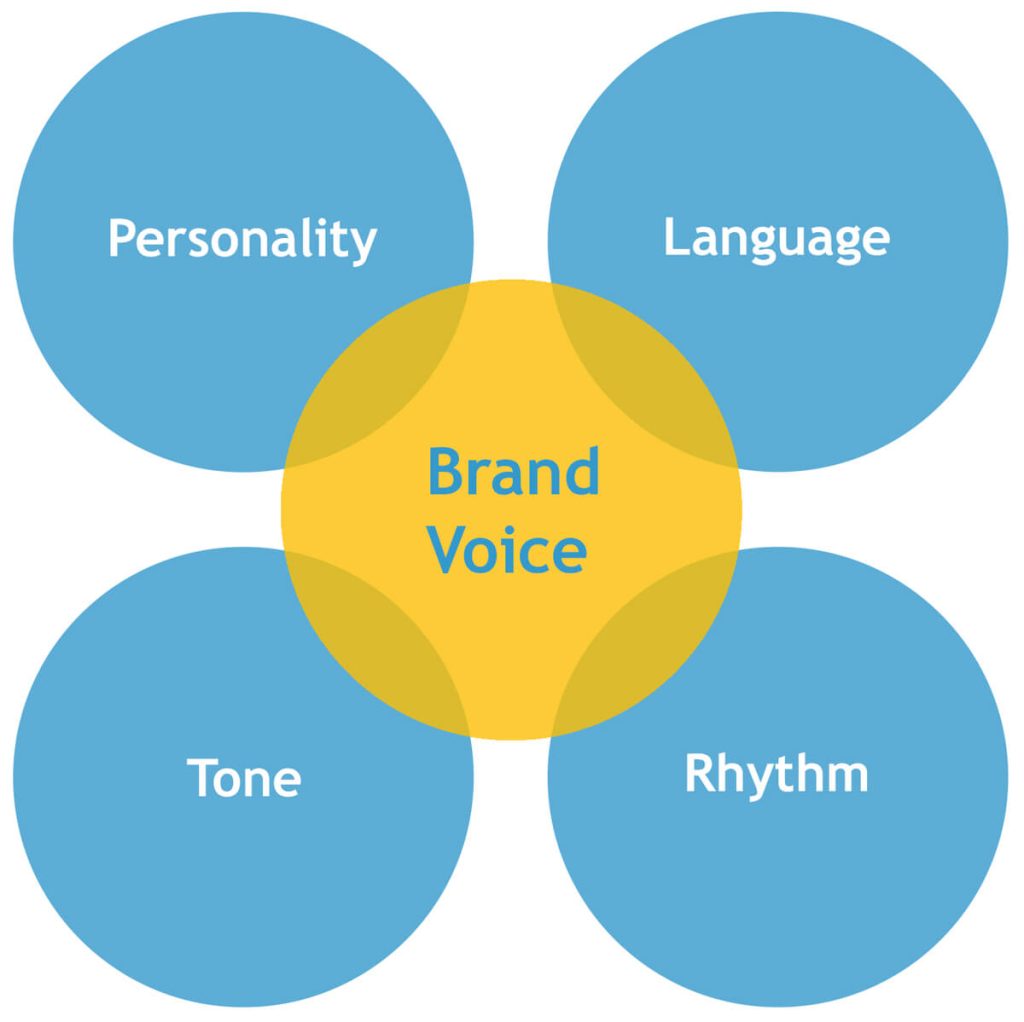What is brand tone of voice?
Essentially, brand tone of voice is about what your brand says and how it says it.
What you say, is your brand messaging. That’s a post for another day.
How you say it, is how your brand should “speak” and sound when it communicates with its audience — particularly in writing. It’s a combination of your brand’s foundations and personality, the tone you set, the language you use, and the rhythm of your words.
Your tone might be warm and fuzzy if you sell teddy bears, or cold and cruel if you’re an evil tyrant, hellbent on world domination — mwahaha!
You could think of brand voice like this
In life, everyone you meet has a different character and a different way of speaking. Your best friend doesn’t speak to you like your doctor and your personal trainer doesn’t speak to you like your accountant. They all sound different. Or, at least, I hope they do.

For example, your:
- Best friend might be warm, familiar and humorous
- Doctor could be expert, compassionate and reassuring
- Personal trainer might be motivational, inspiring and goal-oriented
- Accountant could be sensible, frank and logical.
The same is true for brands. They should all sound different, too.
And with more content being created by AI these days, having a unique brand voice is more important than ever.
Why does AI make having a brand voice more important?
AI works by following algorithms and machine learning protocols. The raw output has its own tone and falls into familiar stylistic patterns and structures.
This is why a lot of AI-written content ends up sounding the same. It’s also what makes it easy for people to spot it. And when they do, they’re often less than impressed.
In a 2024 survey, more than 85% of readers said they believed they could tell when an article was created using AI. And 79% of readers said they view brands that post AI content less favourably.
Survey by Studio Cotton
Having a distinctive brand voice will give you a communication style that’s unique to you. And it will stop you from sounding like competing brands — especially if those brands are using AI to write their content.
How will tone of voice help my brand?
Having a defined tone of voice will help your brand in a number of ways:
It will give your brand a distinctive ‘sound’
The marketing space is full of the same old noise. Even more so now we have AI joining in.
Now, imagine all those brands blah-blah-blahing for attention and think about how you’re going to stand out.
If you’re only adding to their noise, you’ll end up having to be louder just to make yourself heard. And, even if that works, it will only work until an even louder brand comes along.
Making a different sound is so much more effective than just being louder. It helps you rise above the noise. Like the beautiful sound of a siren, luring your ideal customers to you. Only without the rocks and drowning and stuff.
It will make your brand sound more human
As the old adage says, people buy from people.
Humans are naturally drawn to other humans and are much more likely to engage with human voices. This is why big brands strive to sound more human and invest in developing a distinctive brand tone of voice.
A brand tone of voice will personify your brand with an appropriate tone and engaging personality that grabs your audience and speaks their language.
It will mean your copy is always consistent
If you’re a larger business, you might have multiple people or departments creating your brand communications. In this case, there’s a risk your brand could end up sounding like lots of different people.
Having a brand tone of voice guide for all these people to follow will help keep your brand voice consistent and unified. So it always sounds like the same voice — even when it isn’t.
What determines how a brand should sound?
So you’ve decided you want to craft a brand voice. But how do you know what kind of voice your brand should have?

Brand tone of voice is designed to personify your brand, bringing the character, personality and qualities that will make it sound like a real person.
Like a real person, your brand is made up of layers that shape its character and provide its unique qualities. These will all help to determine your brand’s messaging and sound.
Let’s break those down.
Your brand values, vision and mission
Your brand values are what your brand stands for and its reason for being.
Your brand vision is your goal for the future. This is about how you’re making a difference and what you’re striving for, beyond making money.
Your brand mission covers the practical things you’re doing to make that vision a reality.
These three things underpin your brand and should be factors in the message it’s sending and how it sounds .
Your brand’s story and history
These concern your brand’s origin story and its evolution over time. In other words, where it came from, how it’s progressed and where it’s going.
These things are integral to your brand, how it started and how it’s been shaped into what it is today, so they definitely deserve to be heard in your voice.
Your brand’s target audience(s)
Your target audience are the people you’re talking to when you write.
Your brand could have several different target audiences and may need a slightly different voice for each one.
For example:
- Customers/clients
- The general public
- Suppliers
- Internal staff
- Partners/affiliates
- Stakeholders.
Your brand voice should take account of who you’re talking to and where — whether that’s publicly on social media or privately in company emails.
Industry standards
Some industries have norms in terms of personality and tone. For example, brands offering legal and financial services will typically sound formal, masterful and businesslike. And they might flex their industry terminology to demonstrate their prowess.
If you’re in an industry like that, you might feel compelled to follow convention and fall into line with your competitors. Or you could go against the flow with a more human and plain-speaking approach.
Your communication channels
You’ll probably need to vary your brand voice according to the communication channels you’re using.
For example, your private emails will probably have a different vibe than your social media posts.
The four elements of a brand voice
A brand voice is typically made up of four different elements:
- The personality of your brand
- The language you use to communicate
- The tone, which sets the mood
- The rhythm of your words.
Let’s break those down and look at each one.

Personality
Imagine your brand is a person and think about that person’s:
- Thoughts and feelings
- Attitude and opinions
- Actions and mannerisms
- Relationship with their audience
- Speaking voice and choice of words.
Giving your brand its own personality will give it the human qualities that attract and engage other people.
A rounded and authentic brand personality will embody all the elements that come together to make up your brand.
For example, your:
- Values and stance
- Vision and mission
- Story and history
- Target audience
- Creativity and expression
- Experience and expertise.
And perhaps a pinch of your personality, if you’re running a solo business or you’re a founder of a larger business.
Language
Language defines your use of words and vocabulary.
To make it chime with your target audience, you should be using their language. In copywriting circles, we call this Voice of Customer. Using the voice of your customer in your copy helps to make your target audience feel seen and understood.
Tone
Tone covers the moods, feelings and attitude you want to convey.
You might have a general tone you like to use in your communications, but the overriding tone will change according to the content of your message.
For example, a reflective message about the end of a formerly popular product line wouldn’t have the same upbeat tone as a new product announcement.
Rhythm
Rhythm is all about the tempo, energy, flow and structure of your copy. This can be conveyed in your punctuation, the lengths of your sentences and the flow of your words.
For example, short, punchy sentences sound bold, confident and contemporary. Like vibrant paint colours being splatted onto a blank canvas. Longer sentences can flow around a subject, feeling more relaxed and thoughtful. Like a gentle wind on the sail of a boat.
The last word
Your brand voice should be consistent and distinctive. To your target audience, and those who follow your brand, it should always feel familiar. Ideally, they should be able to recognise you by what you say and the way you sound.
There will be things you always say — and will probably say repeatedly. Because repeating the same messages is key to gaining trust and attracting new business.
There will be things you never say — and if you did say them, they’d be perceived as completely out of character.
Need some help to create a tone of voice that works for your brand?
Allow me to introduce myself.
I’m Jenny Lucas. A freelance copywriter based in Leicester, at the heart of the UK.
I specialise in writing for brands that want to showcase their differences and what makes them special. And creating a unique brand tone of voice is part of this process.
That could be a brand tone of voice, I use when I write for you. Or a brand tone of voice guide that will set out your brand voice in a way that anyone who writes for you can use and understand.
Your tone of voice guide will include a full breakdown of your voice in relation to your brand, with a clear definition of each component and usage examples. It will also include a guide for elements such as numbers, symbols and capitalisation. So anything anyone writes for you will follow the same, consistent style.
If you’d like to talk to me about your brand tone of voice and find out more about how I can help, please contact me, using the form on my contact page to send me a message >>

You might also like…



